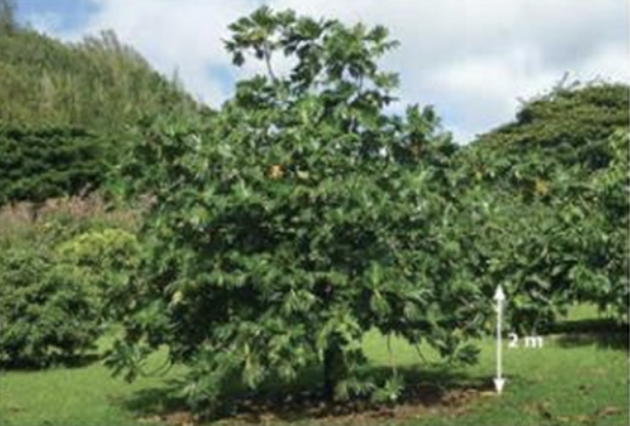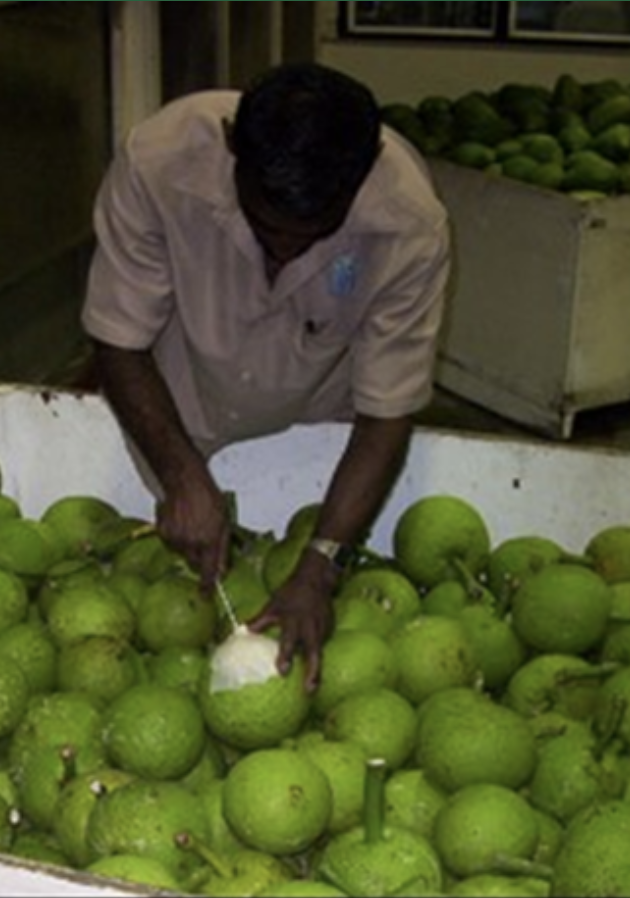Maintenance
Weed control is easier with an agroforestry orchard system compared to a monoculture system because the mix of crops used in such a system ought to generally provide dense cover and therefore will shade the ground, inhibiting weed growth. When planning your system you are best to include species that will quickly cover the ground and also some that will persist for many years. If you plan carefully, removing weeds will be a minor time input and therefore will add little cost.
How important is pruning?
Pruning the breadfruit trees is an essential component of maintenance because it increases the efficiency of harvesting, improves fruiting because the fruit is borne on new growth, removes any weak or damaged branches that could break and damage fruit (and possibly injure people), and finally a well-pruned tree will suffer less damage in high winds and therefore recover more quickly after any storm damage.
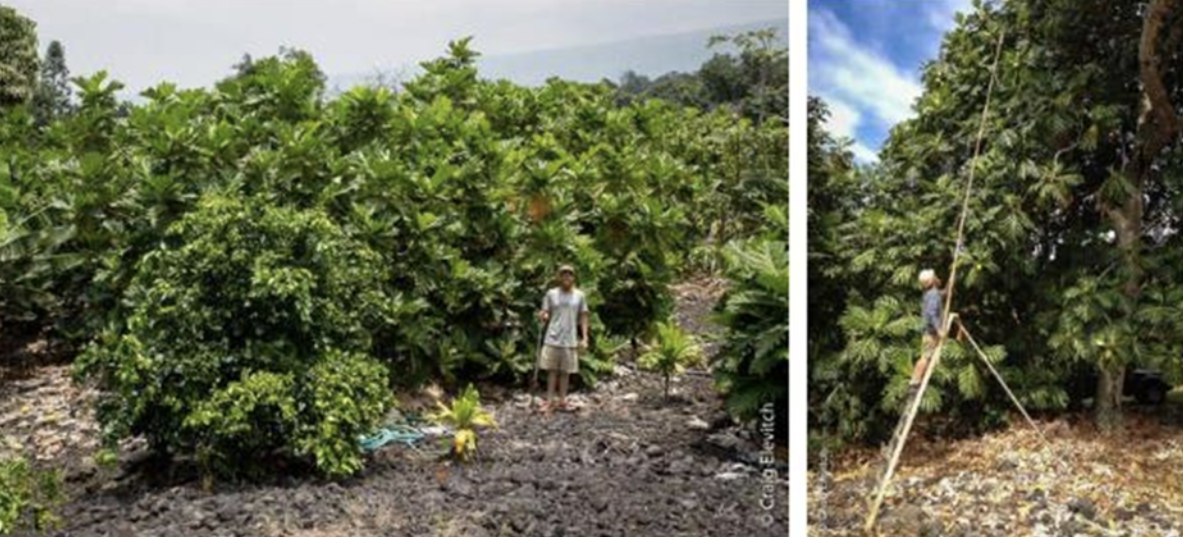
Figure 4: Pruned trees (left) can be efficiently & cost-effectively harvested. An unpruned tree (right) often requires 2-3 x more time to safely pick without climbing the tree or dropping fruit on the ground making it impractical for commercial purposes.
Pruning starts when the tree is small (< 3 m) so that the branch structure can be managed. Ideally annual pruning is carried out after the end of a fruiting cycle, prior to a new growth flush. There should also be adequate soil moisture so that the trees will regrow quickly. The material from pruning (prunings) can be chopped or chipped to provide mulching material. Around the time of pruning, adding soil amendments, mowing ground cover crops and applying additional mulch may be carried out to ensure favourable conditions for regrowth. Pruning is stressful to trees and results in open wounds that need to heal, therefore any extra care (e.g. application of grafting mastic to wounds, fertilisation) that can be given to the trees after pruning will help them to recover and grow well. The pictures below (Figs. 5a-5c) from the Breadfruit Production Guide show appropriate pruning for young tree stage. Also see the video from Hawaii on pruning of your breadfruit tree.
|
|
Figure 5a: For young trees, it is important to control vigorous shoots both from the top and sides. Crown reduction throughout the canopy – rather than only topping – is the best practice. |
|
|
Figure 5b: The first pruning should be done as needed, usually by Year 3 or 4. Prune back to a strong branch union. Take care to remove aggressive shoots and co-dominant leaders. Prune only branches that need to be pruned to shape the tree to an even domed canopy. |
|
|
Figure 5c: A pruning height of 4.5-5.5m is recommended. Prune back to the same height each year. You can seek professional advice if you feel it is needed. |
Pruning is a skill that requires training or the employment of an experienced arborist at the required times. It is important to prune on the collar using a pruning saw to keep wounds to minimum size and so they quickly grow over. Work safety practices must be adhered to and these will depend on the size of the tree and other factors.
Nutrient management
Nutrient management is complex, depending on the soil characteristics, environmental effects, the crops being grown together and the overall management. The Breadfruit Production Guide suggests different approaches to nutrient management but these recommendations are based mainly on orchard systems and therefore might not be as appropriate for well-crafted agroforestry-based systems. As discussed in the Breadfruit Agroforestry Guide agroforestry systems are better at retaining plant nutrients and recycling from depth. Best practice is to base nutrient management on regular soil and plant tissue tests for nutrient status supplemented by your regular observations of plant health.
Pests and diseases
Breadfruit is generally considered to be a relatively pest and disease-free tree, but problems can occur with several fungal diseases and some pests (Figs. 6a-c). Insect pests are whitefly, scale, mealy bug, and fungal diseases include fruit rot (Phytophthora palmivora), brown stem rot (Phellinus noxius) and anthracnose (Colletotrichum gloeosporioides). Breadfruit is also a fruit fly host. This may not be a production problem but it poses a major quarantine/market access issue for fresh breadfruit exports.
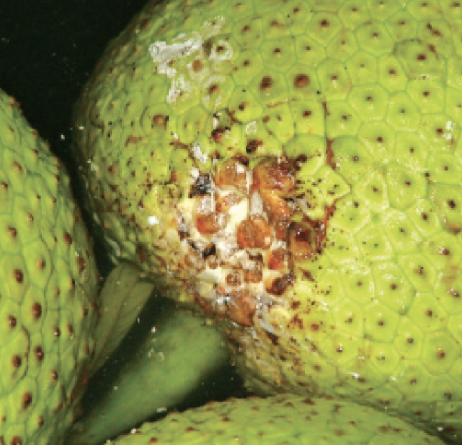 |
Figure 6a: Fruit Rot
Fruit rot is caused by the same pathogen that causes black pod in cocoa. The main control strategy is good site selection and field sanitation. In Samoa, the harvesting of all mature fruit and the removal of diseased fruit was found to effectively control fruit rot. |
|
|
Figure 6b: Brown stem rot
Brown stem rot is a serious breadfruit disease, which in extreme situations can kill the tree. At present, no control measures are available. However, to minimize the risk of the disease spreading, trees should not be planted too closely. |
|
|
Figure 6c: Whitefly
Whitefly, scale and mealy bugs are insect pests of concern and biosecurity officers from importing countries can be expected to order fumigation if these pests are detected; fumigation will destroy breadfruit. These pests are usually found around the fruit stalk. Care must be taken in removing these pests as breadfruit skin is very sensitive – any rough abrasion will lead to more sap release, bruising, blackening and reduced shelf life. |
How do I manage pests and diseases?
Proper care of the trees and good sanitation practices are all essential to reduce the risk of any of the pest and disease problems getting out of control, for example, mealy bug can be a serious problem if trees are stressed by drought and/or poor care. Proper care includes removing diseased fruit, removing dead and dying branches and mulching. Fruits should not be allowed to fully ripen on the tree, fall to the ground and rot. Good air circulation around and under the canopy is also important.
If considering exporting fresh fruit then fruit fly is a pest of specific concern. In Fiji, breadfruit is a host to the fruit fly species, Bactrocera xanthodes. In order to export breadfruit to New Zealand, Pacific Island farmers and exporters must follow an agreed quarantine pathway, which includes bait spraying (Fig. 7), high temperature forced air (HTFA) treatment (Fig. 8) and upper limits to the size of fruit that can be exported.
What does bait spraying involve?
Female fruit flies need to ingest protein before they lay their eggs. Protein obtained from the waste yeast left over after the brewing of beer, and to which insecticide has been added, can be sprayed on the underside of leaves. The protein induces rapid bacterial growth, generating an odour which attracts female fruit flies. The flies eat the protein along with the added insecticide and are killed. Because the bait attracts the flies, it is not necessary to spray the entire foliage. This reduces the risk of pesticide residue in the fruit as well as the loss of pollinators and other desirable insects
HTFA treated breadfruit sourced from bait sprayed orchards is permitted for export to New Zealand. It is expected that a similar export pathway will soon be in place for the Australian and USA markets. For fresh export all care must be taken to ensure that bait spray procedures are correctly followed together with the necessary field sanitation measures.
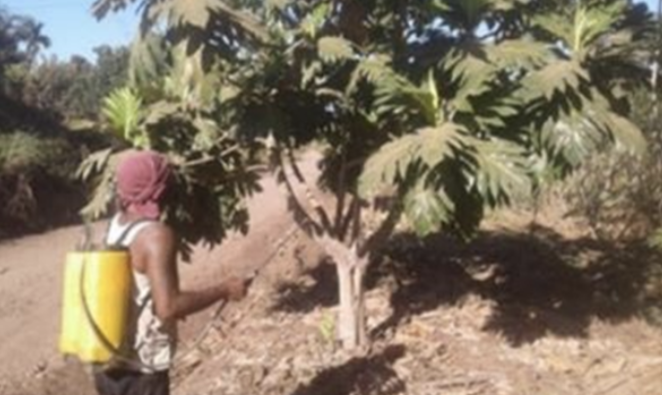 |
Figure 7: Bait spraying breadfruit prior to HTFA treatment (Sahn Ali orchard Buabua, Lautoka, Fiji |
|
|
Figure 8: Breadfruit being probed for HTFA quarantine treatment at Nature’s Way Cooperative Fiji |

